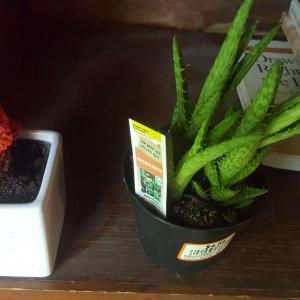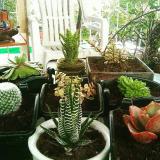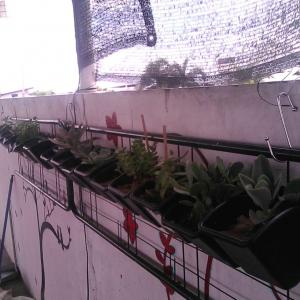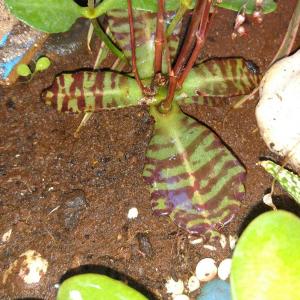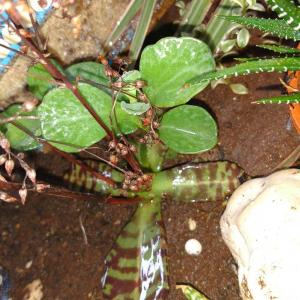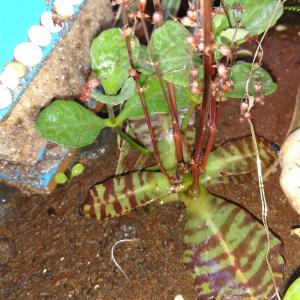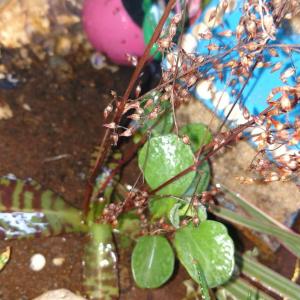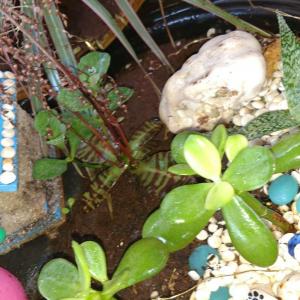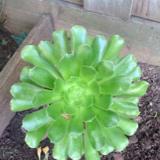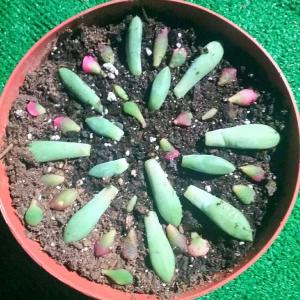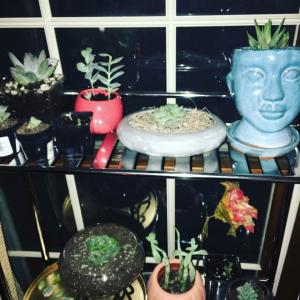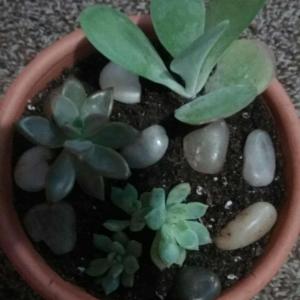文章
Dummer. ゛☀
2017年08月04日

Sempervivum, also known as “houseleeks” or “hen and chick” plants, are among the most popular succulents. They are exceptionally hardy plants and seem to thrive in cold and hot, low light or strong light. They are closely related to echeveria, kalanchoe, and crassula, which all belong to the Crassulaceae family. There is a very wide variety of sempervivum, and they are easily pressed into service as beautiful mixed-dish gardens.

Growing Conditions
Light: Full sun. Perfect for a sunny window.
Water: Water during the summer and spring, making sure drainage is immaculate. Reduce water in the winter to monthly.
Temperature: Prefers average summer temps (65ºF - 70ºF). In winter, some varieties can withstand temperatures down to freezing.
Soil: A well-drained succulent mix, with an ideal pH around 6.0 (slightly acidic).
Fertilizer: Feed with a controlled-release fertilizer in the beginning of the season or weekly with a weak liquid solution. Use a balanced 20-20-20 fertilizer at 1/4 strength on mature plants, and a fertilizer with less nitrogen on young plants.
Propagation
Sempervivum earned their popular name “hen and chicks” from their growth habit. The mother plant, or hen, sends off numerous offsets, which will cluster around her base like chicks. These offsets can be easily repotted, or the plants can be left to form a clumping mat.

Repotting
Repot as needed, preferably during the warm season. To repot a succulent, make sure the soil is dry before repotting, then gently remove the pot. Knock away the old soil from the roots, making sure to remove any rotted or dead roots in the process. Treat any cuts with a fungicide. Place the plant in its new pot and backfill with potting soil, spreading the roots out as you repot.
Leave the plant dry for a week or so, then begin to water lightly to reduce the risk of root rot.

Varieties
There are many hybrids and species of sempervivum, and they all feature similar growth habits. The most popular in the garden trade is the S. tectorum, which is a very attractive plant that grows in tight rosettes of plump leaves with red tips. Another sempervivum, the S. arachnoideum, appears to be coated in a fine web of hairs.
Grower's Tips
Sempervivum are not difficult to grow, provided they are not waterlogged and killed from excess watering. They can be easily grown outdoors and in containers, and they earned the name “houseleeks” from their tendency to root on the roofs of houses. After the mother plant flowers, it will naturally die, but by this time, the plant has likely produced many offsets that will continue to grow. These are excellent for cold windows.

Growing Conditions
Light: Full sun. Perfect for a sunny window.
Water: Water during the summer and spring, making sure drainage is immaculate. Reduce water in the winter to monthly.
Temperature: Prefers average summer temps (65ºF - 70ºF). In winter, some varieties can withstand temperatures down to freezing.
Soil: A well-drained succulent mix, with an ideal pH around 6.0 (slightly acidic).
Fertilizer: Feed with a controlled-release fertilizer in the beginning of the season or weekly with a weak liquid solution. Use a balanced 20-20-20 fertilizer at 1/4 strength on mature plants, and a fertilizer with less nitrogen on young plants.
Propagation
Sempervivum earned their popular name “hen and chicks” from their growth habit. The mother plant, or hen, sends off numerous offsets, which will cluster around her base like chicks. These offsets can be easily repotted, or the plants can be left to form a clumping mat.

Repotting
Repot as needed, preferably during the warm season. To repot a succulent, make sure the soil is dry before repotting, then gently remove the pot. Knock away the old soil from the roots, making sure to remove any rotted or dead roots in the process. Treat any cuts with a fungicide. Place the plant in its new pot and backfill with potting soil, spreading the roots out as you repot.
Leave the plant dry for a week or so, then begin to water lightly to reduce the risk of root rot.

Varieties
There are many hybrids and species of sempervivum, and they all feature similar growth habits. The most popular in the garden trade is the S. tectorum, which is a very attractive plant that grows in tight rosettes of plump leaves with red tips. Another sempervivum, the S. arachnoideum, appears to be coated in a fine web of hairs.
Grower's Tips
Sempervivum are not difficult to grow, provided they are not waterlogged and killed from excess watering. They can be easily grown outdoors and in containers, and they earned the name “houseleeks” from their tendency to root on the roofs of houses. After the mother plant flowers, it will naturally die, but by this time, the plant has likely produced many offsets that will continue to grow. These are excellent for cold windows.
0
1
文章
Dummer. ゛☀
2017年08月04日

Echeveria are very popular succulents that grow in attractive rosettes with beautiful leaves in a variety of colors and sometimes stunning flowers. These plants have been extensively hybridized, so in addition to the main species, there are many varieties that have been specially bred for interesting leaf form and color.
Most Echeveria will remain fairly small (a few inches to a foot across), but some species will grow to small shrub-like plants of 2 feet.
Members of the Crassulaceae family, their care is similar to sedum and kalanchoe succulents.

Growing Conditions
Light: Full sun. Perfect for a sunny window.
Water: Water during the summer and spring, making sure drainage is immaculate. Reduce water in the winter to monthly.
Temperature: Prefers average summer temps (65 degrees F - 70 degrees F). In winter, cool to 50 degrees F.
Soil: A well-drained succulent mix, with an ideal pH around 6.0 (slightly acidic).
Fertilizer: Feed with a controlled-release fertilizer in the beginning of the season or weekly with a weak liquid solution. Use a balanced 20-20-20 fertilizer at 1/4 strength on mature plants, and a fertilizer with less nitrogen on young plants.
Propagation
Most Echeveria can be easily propagated from leaf cuttings, although a few are better from seeds or stem cuttings. To propagate a leaf cutting, place the individual leaf in a succulent or cacti mix and cover the dish until the new plant sprouts.

Repotting
Repot as needed, preferably during the warm season. To repot a succulent, make sure the soil is dry before repotting, then gently remove the pot. Knock away the old soil from the roots, making sure to remove any rotted or dead roots in the process. Treat any cuts with a fungicide.
Place the plant in its new pot and backfill with potting soil, spreading the roots out as you repot.
Leave the plant dry for a week or so, then begin to water lightly to reduce the risk of root rot.
Varieties
There are many popular Echeveria, both species and hybrids. In nature, Echeveria are native to Mexico, the United States, and down into South America. Some of the more beautiful Echeveria include the blue Echeveria (E. glauca and E. laui), firecracker plant (E. setosa), painted lady (E. derenbergii), and E. agavoides.

Grower's Tips
Most of the common Echeveria species are not complicated succulents to grow, provided you follow a few basic rules. First, be careful never to let water sit in the rosette as it can cause rot or fungal diseases that will kill the plant.
Additionally, remove dead leaves from the bottom of the plant as it grows. These dead leaves provide a haven for pests, and Echeveria are susceptible to mealy bugs. As with all succulents, careful watering habits and plenty of light will help ensure success.
Most Echeveria will remain fairly small (a few inches to a foot across), but some species will grow to small shrub-like plants of 2 feet.
Members of the Crassulaceae family, their care is similar to sedum and kalanchoe succulents.

Growing Conditions
Light: Full sun. Perfect for a sunny window.
Water: Water during the summer and spring, making sure drainage is immaculate. Reduce water in the winter to monthly.
Temperature: Prefers average summer temps (65 degrees F - 70 degrees F). In winter, cool to 50 degrees F.
Soil: A well-drained succulent mix, with an ideal pH around 6.0 (slightly acidic).
Fertilizer: Feed with a controlled-release fertilizer in the beginning of the season or weekly with a weak liquid solution. Use a balanced 20-20-20 fertilizer at 1/4 strength on mature plants, and a fertilizer with less nitrogen on young plants.
Propagation
Most Echeveria can be easily propagated from leaf cuttings, although a few are better from seeds or stem cuttings. To propagate a leaf cutting, place the individual leaf in a succulent or cacti mix and cover the dish until the new plant sprouts.

Repotting
Repot as needed, preferably during the warm season. To repot a succulent, make sure the soil is dry before repotting, then gently remove the pot. Knock away the old soil from the roots, making sure to remove any rotted or dead roots in the process. Treat any cuts with a fungicide.
Place the plant in its new pot and backfill with potting soil, spreading the roots out as you repot.
Leave the plant dry for a week or so, then begin to water lightly to reduce the risk of root rot.
Varieties
There are many popular Echeveria, both species and hybrids. In nature, Echeveria are native to Mexico, the United States, and down into South America. Some of the more beautiful Echeveria include the blue Echeveria (E. glauca and E. laui), firecracker plant (E. setosa), painted lady (E. derenbergii), and E. agavoides.

Grower's Tips
Most of the common Echeveria species are not complicated succulents to grow, provided you follow a few basic rules. First, be careful never to let water sit in the rosette as it can cause rot or fungal diseases that will kill the plant.
Additionally, remove dead leaves from the bottom of the plant as it grows. These dead leaves provide a haven for pests, and Echeveria are susceptible to mealy bugs. As with all succulents, careful watering habits and plenty of light will help ensure success.
4
4
文章
Dummer. ゛☀
2017年08月04日

Succulents are booming in popularity for two simple reasons: they are beautiful and nearly indestructible.
Technically, a succulent is any plant with thick, fleshy (succulent) water storage organs. Succulents store water in their leaves, their stems or their roots. These plants have adapted to survive arid conditions throughout the world, from Africa to the deserts of North America. Fortunately for us, this adaptive mechanism has resulted in an incredible variety of interesting leaf forms and plant shapes, including paddle leaves, tight rosettes, and bushy or trailing columns of teardrop leaves.

As a group, succulents include some of the most well-known plants, such as the aloe and agave, and many almost unknown plants. Cacti are a unique subset of the succulent group. Succulents make excellent display plants in dish gardens.
The Rules for Growing Succulent Houseplants
No matter what kind of succulent you're growing, the rules are pretty similar between the different species. Here are the general rules for growing top-quality succulents:
Southern Light
Succulents prefer bright light, such as found on a south-facing window. Watch the leaves for indications that the light level is correct. Some species will scorch if suddenly exposed to direct sunlight. The leaves will turn brown or white as the plant bleaches out and the soft tissues are destroyed. Alternatively, an underlit succulent will begin to stretch, with an elongated stem and widely spaced leaves. This condition is known as etoliation.

The solution is to provide better light and prune the plant back to its original shape. Many kinds of succulents will thrive outdoors in the summer.
Temperature
Succulents are much more cold-tolerant than many people assume. As in the desert, where there is often a marked contrast between night and day, succulents thrive in colder nights, down to even 40ºF.
Ideally, succulents prefer daytime temperatures between 70 F and about 85 F and nighttime temperatures between 50 F and 55 F.
Watering
Succulents should be watered generously in the summer. The potting mix should be allowed to dry between waterings, but do not underwater. During the winter, when the plants go dormant, cut watering back to once every other month. Overwatering and ensuing plant rot is the single most common cause of plant failure. Be aware, though, that an overwatered succulent might at first plump up and look very healthy. However, the cause of death may have already set in underground, with rot spreading upward from the root system. A succulent should never be allowed to sit in water. The following are signs of under- or overwatering:
Overwatering. Overwatered plants are soft and discolored. The leaves may be yellow or white and lose their color. A plant in this condition may be beyond repair, but you can still remove it from its pot and inspect the roots. If they are brown and rotted, cut away dead roots and repot into drier potting media, or take a cutting and propagate the parent plant.
Under-watering: Succulents prefer generous water during the growing season (spring and summer). An under-watered plant will first stop growing, then begin to shed leaves. Alternatively, the plant may develop brown spots on the leaves.

Potting Soil
Succulents should be potted in a fast-draining mixture that's designed for cacti and succulents. If you don't have access to a specialized mix, consider modifying a normal potting mix with an inorganic agent like perlite to increase aeration and drainage. These plants have shallow roots that form a dense mat just under the soil surface.
Fertilizer
During the summer growing season, fertilizer as you would with other houseplants. Stop fertilizing entirely during the winter.
Technically, a succulent is any plant with thick, fleshy (succulent) water storage organs. Succulents store water in their leaves, their stems or their roots. These plants have adapted to survive arid conditions throughout the world, from Africa to the deserts of North America. Fortunately for us, this adaptive mechanism has resulted in an incredible variety of interesting leaf forms and plant shapes, including paddle leaves, tight rosettes, and bushy or trailing columns of teardrop leaves.

As a group, succulents include some of the most well-known plants, such as the aloe and agave, and many almost unknown plants. Cacti are a unique subset of the succulent group. Succulents make excellent display plants in dish gardens.
The Rules for Growing Succulent Houseplants
No matter what kind of succulent you're growing, the rules are pretty similar between the different species. Here are the general rules for growing top-quality succulents:
Southern Light
Succulents prefer bright light, such as found on a south-facing window. Watch the leaves for indications that the light level is correct. Some species will scorch if suddenly exposed to direct sunlight. The leaves will turn brown or white as the plant bleaches out and the soft tissues are destroyed. Alternatively, an underlit succulent will begin to stretch, with an elongated stem and widely spaced leaves. This condition is known as etoliation.

The solution is to provide better light and prune the plant back to its original shape. Many kinds of succulents will thrive outdoors in the summer.
Temperature
Succulents are much more cold-tolerant than many people assume. As in the desert, where there is often a marked contrast between night and day, succulents thrive in colder nights, down to even 40ºF.
Ideally, succulents prefer daytime temperatures between 70 F and about 85 F and nighttime temperatures between 50 F and 55 F.
Watering
Succulents should be watered generously in the summer. The potting mix should be allowed to dry between waterings, but do not underwater. During the winter, when the plants go dormant, cut watering back to once every other month. Overwatering and ensuing plant rot is the single most common cause of plant failure. Be aware, though, that an overwatered succulent might at first plump up and look very healthy. However, the cause of death may have already set in underground, with rot spreading upward from the root system. A succulent should never be allowed to sit in water. The following are signs of under- or overwatering:
Overwatering. Overwatered plants are soft and discolored. The leaves may be yellow or white and lose their color. A plant in this condition may be beyond repair, but you can still remove it from its pot and inspect the roots. If they are brown and rotted, cut away dead roots and repot into drier potting media, or take a cutting and propagate the parent plant.
Under-watering: Succulents prefer generous water during the growing season (spring and summer). An under-watered plant will first stop growing, then begin to shed leaves. Alternatively, the plant may develop brown spots on the leaves.

Potting Soil
Succulents should be potted in a fast-draining mixture that's designed for cacti and succulents. If you don't have access to a specialized mix, consider modifying a normal potting mix with an inorganic agent like perlite to increase aeration and drainage. These plants have shallow roots that form a dense mat just under the soil surface.
Fertilizer
During the summer growing season, fertilizer as you would with other houseplants. Stop fertilizing entirely during the winter.
0
0
求助
Ueca
2017年07月27日

What are the species of these succulents? Most of them must be Echeverias but finding the species name is the hardest thing ever.
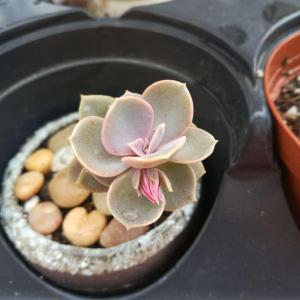
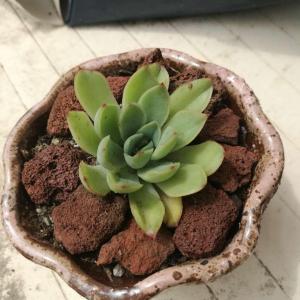
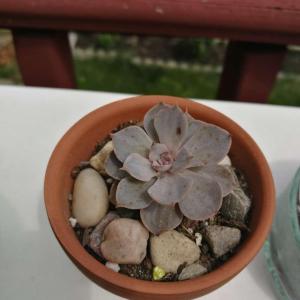
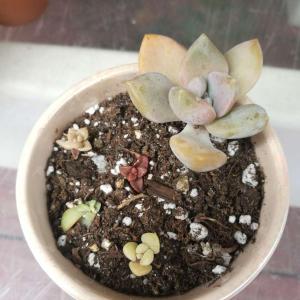
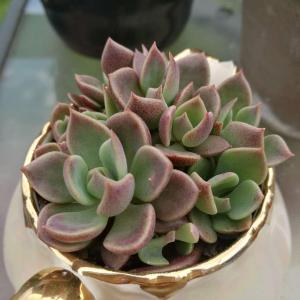
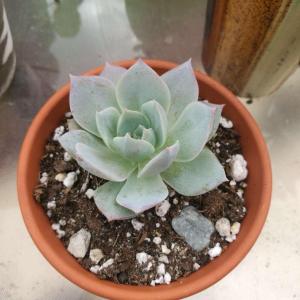
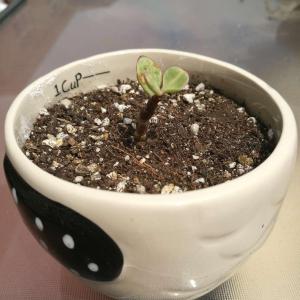
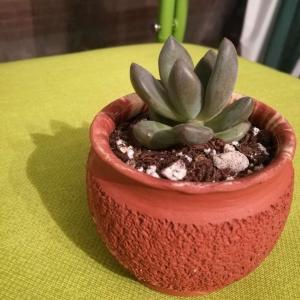
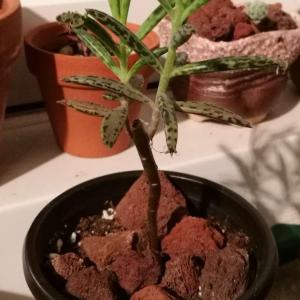









2
1
meriunkat:the last one on the first row to the left looks like portuluca afra "Elephant Bush"
meriunkat:the last one on the second row to the right looks like Echeveria Lola
meriunkat:I have one like that last one on the bottom right corner.. don't know the name either
meriunkat:I'm pretty sure the first one is also a Perle Von Nurnberg, I have one that is growing new leaves and they look like that
meriunkat:@sarajordan2993 I know home Depot and Lowe's do put name tags
显示更多
成长记
stureburk
2017年07月23日
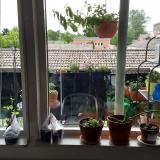
Praise the sun little friend. ☀️ I put her outside in the sunshine during the day, and now the middle leaves stand almost straight up. The reason I take her inside during the night is that the dew keeps him from drying out. Succulents don't like wet feet. Peeking under the leaves I've seen some new roots forming from when I removed all the offshoots from her.


0
0
成长记
meriunkat
2017年07月22日

Anyone have an idea what kind of succulents these might be? they don't grow very much, i believe some have reached there full growth size. I took them out feom under bolders on the Lake Tahoe hiking trails.
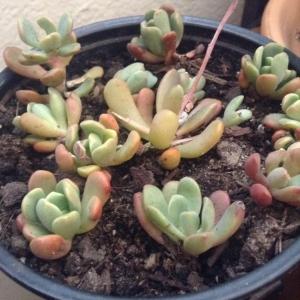

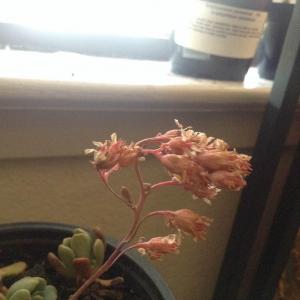



2
0
Abby Gill:My guess is sedum pachyphyllum, but don't take my word for it.



